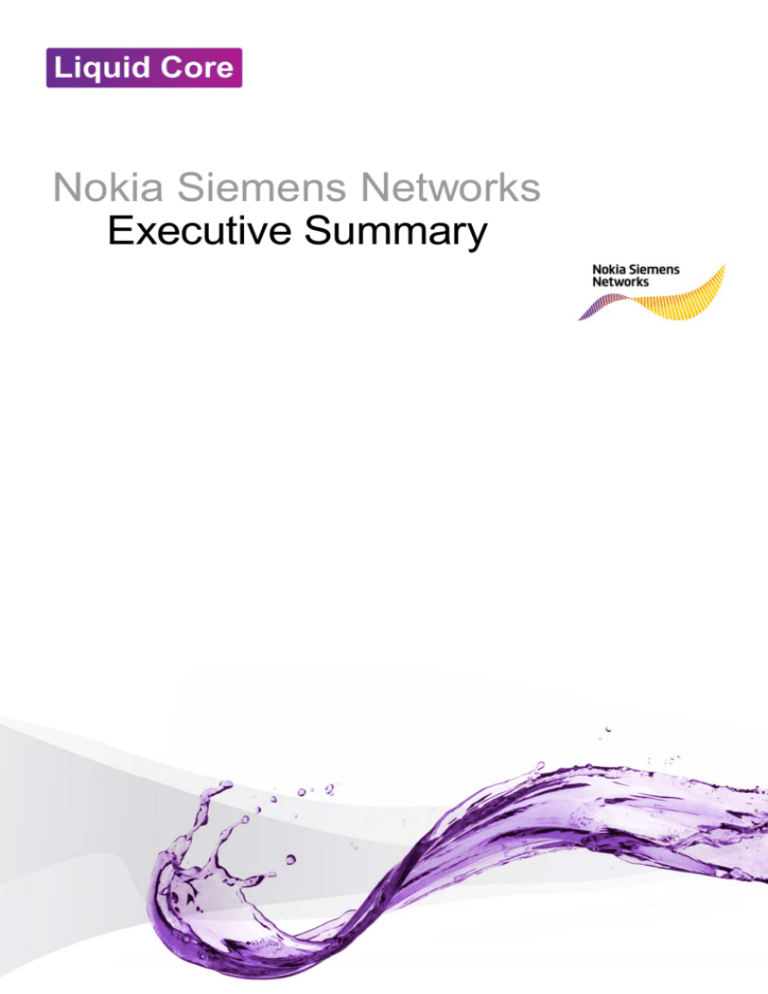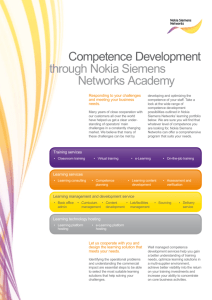
Nokia Siemens Networks
Executive Summary
2/2
Nokia Siemens Networks Liquid Net
Copyright 2012 Nokia Siemens Networks.
All rights reserved.
Liquid Core: adapt flexibly for efficient capacity
on demand
The upsurge in popularity of mobile smart devices, the rising use of fixed
and mobile broadband and the shift to all-IP networks are putting core
networks in the spotlight like never before. To meet exploding data and
voice traffic volumes, core networks must achieve significant improvements
in cost-effectiveness and must also deliver virtually unlimited scalability,
adaptability and efficiency, without disrupting the existing customer
experience.
Part of Nokia Siemens Networks Liquid Net, Liquid Core adds intelligent
software applications that make the core network self-aware. This enables
the core network to adapt and optimize itself to meet the ever-changing
needs of subscribers, the services they use and the operational state of the
network itself.
Liquid Core uses the key enablers of Liquid Net
Liquid Net unleashes frozen network capacity into a reservoir of
resources that can flow to fulfill unpredictable demand, wherever and
whenever people use broadband. Liquid Core implements the four
principles of flexibility that underpin this capability:
Self–aware, self-adapting: The network recognizes where demand
is coming from and instantly reconfigures to deliver the right capacity,
coverage and services to the right places.
Software-defined applications on multi-purpose hardware:
Software-defined network applications run on multi-purpose hardware,
either COTS ATCA®-based or other generic, enabling processing
capacity to be matched to changing demand.
Inter-linked architecture: Infrastructure elements are extensively
inter-connected to allow capacity and processing to flow freely across
the network.
The two pillars of Liquid Core
Evolutionary: Liquid Net takes an evolutionary approach that is nondisruptive, yet also transformational to protect operator investments.
3/3
Nokia Siemens Networks Liquid Net
Copyright 2012 Nokia Siemens Networks.
All rights reserved.
Liquid Core dynamically provides the capacity needed to ensure the best
customer experience at the lowest cost. This capability is achieved through
two key pillars:
Core Virtualization
Core software applications are the ‘intelligence’ of a core network. Core
Virtualization enables any software application to run on COTS (commercialoff-the-shelf) ATCA® and ultimately on other generic multi-purpose
hardware. With hardware-independence, core applications can run on
legacy and new hardware, protecting existing investments and enabling the
operator to take advantage of the latest processor and other technology
developments. By providing an evolutionary roadmap for the Nokia Siemens
Networks Open Core System, Core Virtualization enables operators to
achieve greater hardware efficiency and flexibility by dynamically allocating
network resources, like processing power, to core software applications in
order to handle differing traffic and service needs.
Core Virtualization will develop in stages. First is hardware consolidation to
decouple software from the underlying hardware. Nokia Siemens Networks
has already chosen COTS ATCA as the most beneficial hardware for this
consolidation stage, because ATCA is the specification favored by the
telecommunications industry for carrier-class performance and reliability.
As Core Virtualization evolves further, the virtualization layer will extend
across all core applications, assigning available hardware resources to
multiple applications as needed. Operators can enjoy tremendous flexibility
with network resources being allocated on-the-fly, according to traffic and
service demands and with the capability to adapt easily to new traffic profiles
as they arise. This provides extreme scalability and hardware utilization.
In the near future, Core Virtualization will open up new possibilities, such as
a global operator running common core applications for affiliates in different
time zones, for example, or providing pooled core processing capacity for
short-term events, without investing in additional spare capacity.
Today, this is already driving down the Total Cost of Ownership (TCO).
Fewer hardware modules means up to 80% less floor space and fewer
spares. Energy costs fall by up to 65%, with future evolution improving on
even these figures.
Importantly, all these benefits are achieved without incurring huge disruption
to the core network infrastructure and without damaging existing services for
customers.
4/4
Nokia Siemens Networks Liquid Net
Copyright 2012 Nokia Siemens Networks.
All rights reserved.
SON for Core
Nokia Siemens Networks SON for Core implements intelligent, dynamic
network management to improve the operation of core network elements.
SON for Core introduces automation that helps operators to proactively
detect, analyze and react to changes in traffic demand and network status.
Ranging from automated, event-based, real-time actions, to automated
element configuration, SON for Core’s self-aware, self-adapting capabilities
monitor and help to prevent harmful bottlenecks caused by traffic peaks.
Core network investments are used to their maximum, while increased
automation improves operational efficiency and network stability.
SON for Core comprises two levels:
-
-
Automated network operations management for traffic load
balancing, optimized transport capacity distribution, smart phone
signaling and voice call distribution.
Automated network operations management and flexible allocation
of resources, for example processing capacity, from virtualized
hardware running different core network software applications.
SON for Core is implemented in two main streams. As a distributed function,
SON for Core runs in the core network application itself. When SON for
Core needs to collect, analyze and react across a group of network
elements, then centralized intelligence is needed, which is provided by the
Core Networks Productivity Suite (CNPS). The CNPS can reside on a
NetAct OSS system, on independent servers, or in the Cloud. With SON for
Core, network management automation can be supervised closely and
extended at a pace controlled by the operator.
SON for Core implementation is supported by Services for SON. Each SON
for Core solution can be tailored to suit an operator’s unique requirements.
Customization and process consultation of various aspects of SON for Core,
such as SON policies, rules, algorithms, level of automation and control and
stop points, ensures that SON for Core is implemented in the best way for
each network and in line with an operator’s operational strategy.
SON for Core brings substantial benefits to operators. The total cost of
ownership of SGSNs can be reduced by up to 30%, while optimizing a pool
of MSS applications removes the need for operators to over-dimension
transmission capacity to deal with traffic peaks. Network resources are used
more efficiently, for example A-interface utilization increases by up to 25%.
SON for Core’s Nearest GGSN and Signaling Gateway (SGW) Selection
feature saves the transmission costs between radio and packet core
elements by 50% or more by identifying and selecting co-located network
elements. Call routing optimization saves up to 10% of annual interconnect
fees by quality-optimized least cost routing.
5/5
Nokia Siemens Networks Liquid Net
Copyright 2012 Nokia Siemens Networks.
All rights reserved.
Nokia Siemens Networks
P.O. Box 1
FI-02022 NOKIA SIEMENS NETWORKS
Finland
Visiting address:
Karaportti 3, ESPOO, Finland
Switchboard +358 71 400 4000 (Finland)
Switchboard +49 89 5159 01 (Germany)
Copyright © 2012 Nokia Siemens Networks.
All rights reserved.
Nokia is a registered trademark of Nokia Corporation, Siemens is a registered trademark of
Siemens AG. The wave logo is a trademark of Nokia Siemens Networks Oy. Other company and
product names mentioned in this document may be trademarks of their respective owners, and
they are mentioned for identification purposes only.
This publication is issued to provide information only and is not to form part of any order or
contract. The products and services described herein are subject to availability and change
without notice.









